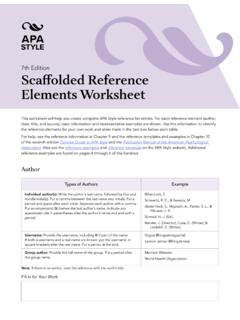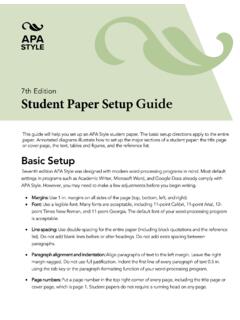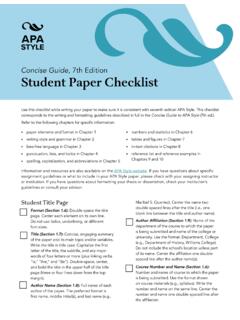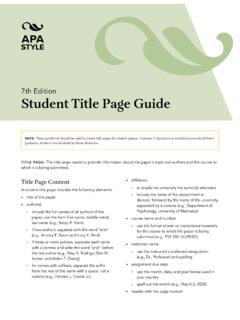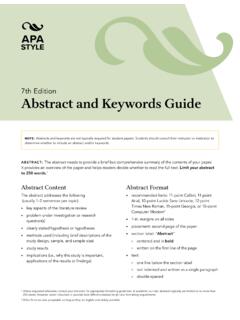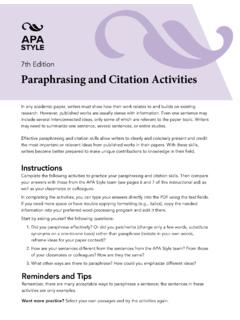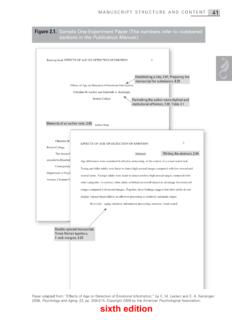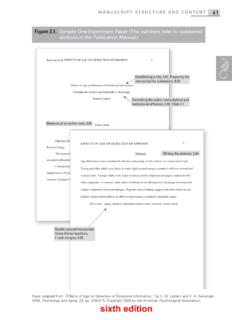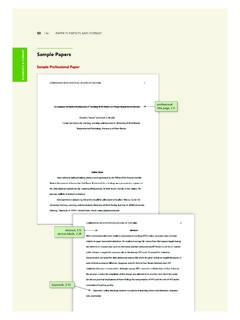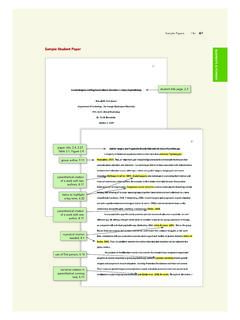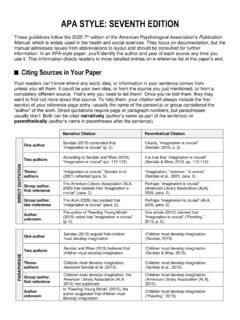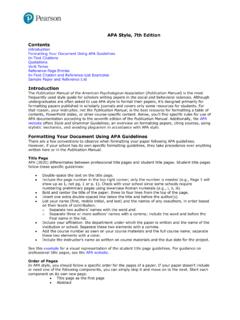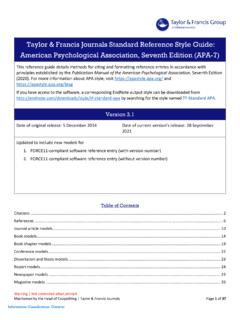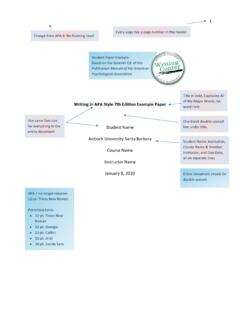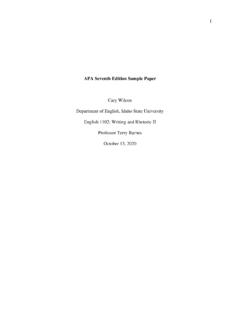Transcription of Guide to What's New in the Publication Manual ... - APA Style
1 Guide to What s New in the Publication Manual of the American Psychological Association, seventh EditionThis document provides an overview of what s new in the seventh edition of the Publication Manual of the American Psychological Association. Content throughout the Manual has been significantly expanded and revised from the sixth edition . Chapter 1 Chapter 1 has new and updated content on scholarly writing and publishing principles. This includes infor-mation about types of journal articles and student papers, ethical and accurate reporting of research results, data retention and sharing (with additional data-sharing considerations for qualitative research), contributions meriting Publication credit, authors intellectual property rights duringmanuscript review, and much 2 Chapter 2 covers paper elements and formatting for both professional and student papers.
2 The summa-ries of Publication Manual sections outlined here focus mostly on changes that affect student paper format-ting, though significant changes to professional papersare also noted. A sample professional paper and a sample student paper are available on the APA Style website and in the Title Page NEWThe seventh edition includes guidelines for student paper title page formatting that are different from professional paper title page formatting. Student title page elements include the course number and name, instructor name, and assignment due date as well as the omission of the running head. Students should follow the guidelines of their instructor or institution when determining which title page format is most appropriate to use. Sample student and professional title pages are provided in the Manual (Figures and ) and in the title page guidelines on the APA Style TitleEXPANDEDThe title of the paper should be in title case, bold,centered, and positioned in the upper half of the titlepage.
3 See this section for additional Author Name (Byline)EXPANDEDThis section includes clearer instructions on how to format a Author AffiliationREVISEDA ffiliations for authors working at different institutions now use a superscript format that involves using Arabic numerals to connect author names to the appropriate affiliations. For all authors, academic affiliations should include the name of any department or division and the name of the institution, separated by a comma. It is not necessary to include the location of the institution unless the location is part of the institution s and additional examples of affiliations are avail-able on the APA Style website. Author NoteREVISEDAn author note is not required for student papers, unless requested by an instructor.
4 This revised section includes information for authors of professional papers about how to format the author note and new content to be included ( , ORCID iDs, study registration, open sharing practices). Running HeadREVISED A running head is not required on student papers,unless requested by an instructor. Professional manuscripts still include a runninghead of 50 characters or fewer. The words Runninghead: no longer appear as a label on the first page. See the professional sample paper on the APAS tyle website for examples of the seventh editionrunning AbstractREVISEDAn abstract is not required for student papers, unless requested by an instructor. This revised section includes guidelines for formatting abstracts, including structured KeywordsNEWK eywords are not required for student papers, unless requested by an instructor.
5 This section includes guidance about how to format keywords in professional Text (Body)EXPANDEDThis section describes how to format the text of the paper, including considerations for paper organization. The paper title appears at the top of the first page of the text in bold and Reference ListREVISEDThis section describes how to format the reference list. The label References is now FootnotesEXPANDEDThis section has instructions on how to create a call-out to a footnote in the text, number footnotes, and format footnotes listed on a separate Appendice sEXPANDED AND REVISEDThis section has clearer guidance on how to label and format different types of appendices. The label Appendix is now Supplemental MaterialsEXPANDED AND NEWThis section includes examples of and considerations for content in supplemental materials as well as new suggestions for making content accessible for all 7 Order of PagesEXPANDEDThis section outlines the order of pages in a paper, including a more flexible placement of tables and figures: either embedded in the text after they are first called out or on separate pages after the reference list.
6 See also information on the order of pages on the APA Style website. P age H eaderEXPANDED AND REVISEDThis section includes instructions on where to place elements in the page header and details revised elements tailored to meet the different needs of papers for professionals (page number and running head) and students (page number only). See also infor-mation on page headers on the APA Style website. FontREVISED Font guidelines are more flexible. This revisedsection notes that APA Style papers shouldbe written in a font that is accessible to allusers. Section provides the following fontrecommendations: a sans serif font such as 11-point Calibri, 11-pointArial, or 10-point Lucida Sans Unicode or a serif font such as 12-point Times New Roman,11-point Georgia, or normal (10-point) ComputerModern (the latter is the default font for LaTeX).
7 2 Students and other authors may choose other fonts,as needed, but should keep accessibility in mindwhen doing so. The APA Style website containsfurther discussion of font and accessible typography. Because different fonts take up different amountsof space on the page, we recommend using wordcount rather than page count to gauge paperlength (see Section for more information aboutpaper length). Line Spacing EXPANDEDG eneral guidance to double-space the paper is provided, followed by line spacing for specific paper sections: title page, table body, figure image, foot-notes, and displayed equations. Do not add lines before or after headings or between MarginsEXPANDEDThe section on margins addresses possible adjust-ments needed for margins in dissertations and theses compared to journal articles.
8 See also information on margins on the APA Style website. Paragraph AlignmentEXPANDED This section describes how to align paragraphs tothe left margin. See also information on paragraphalignment on the APA Style website. Formatting of long DOIs or URLs is outlined: (a) linebreaks should not be manually inserted, and (b)breaks applied automati cally by a word-processingprogram are Paragraph IndentationEXPANDEDThis section describes guidance for paragraph inden-tation as well as exceptions needing different inden-tation: title page, abstract, section labels, appendix labels and titles, headings, block quotations, tables and figures, and reference entries. See also infor-mation on paragraph indentation on the APA Style Paper LengthEXPANDED AND NEWThis section includes a recommendation to use word count rather than page count to determine paper length when possible.
9 When using word count, count all words in text, references, table bodies, table and figure notes, and Principles of OrganizationEXPANDEDThis section includes a discussion of how and why to use headings to effectively organize and structure a HeadingsREVISEDThe following table demonstrates how to format head-ings in seventh edition APA Style . All headings are bold; Levels 3 and 5 are also italic. LevelSeventh edition Format1 Centered, Bold, Title Case HeadingText begins indented as a new Left, Bold, Title Case HeadingText begins indented as a new Left, Bold Italic, Title Case HeadingText begins indented as a new , Bold, Title Case Heading, Ending With a Period. Text begins on the same line andcontinues as a regular Indented, Bold Italic, Title Case Heading, Ending With a Period.
10 Text begins on the same line and continues as a regular more details about how to format headings, including headings in the introduction of a paper, see information about headings and headings in sample papers on the APA Style Section LabelsREVISED All section labels ( , Author Note, Abstract, References ) are now bold. The chapter ends with full samples of both studentand professional papers with labels to show howspecific elements appear when implemented andwhere in the Manual to find more 3 Chapter 3 orients writers to journal article reporting standards (JARS) and includes tables outlining stan-dards for reporting quantitative, qualitative, and mixed methods research. JARS was significantly updated to provideguidance for not only quantitative research but alsoqualitative and mixed methods Substantial content in Chapter 3 and throughoutthe Publication Manual addresses the unique needsof qualitative and mixed methods 4 Chapter 4 provides guidance on writing Style and grammar.
